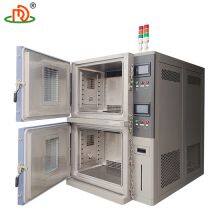Supplier of Double-layer Constant Temperature and Humidity Test Chamber
SPECIFICATION
The installation requirements for a dual-chamber constant temperature and humidity test chamber are crucial to ensure the equipment operates correctly and provides stable environmental control. Below are the common installation requirements and considerations:
1. Installation Environment RequirementsAmbient Temperature: The test chamber should be installed indoors, away from exposure to extreme temperatures, large fluctuations in humidity, or harsh environmental conditions. Typically, the ambient temperature should be between 10°C to 30°C, as very high or low temperatures can affect the device's normal operation.
Ambient Humidity: The surrounding humidity should be maintained between 50% and 70% RH. Extremely high or low humidity may impact the equipment's performance.
Ventilation: The installation site should have good ventilation to ensure proper heat dissipation. The test chamber’s cooling system requires sufficient space for air circulation to prevent overheating.
Level Installation: The test chamber should be installed on a level surface to avoid tilting, which could affect the stability of the equipment and the accuracy of test results.
Voltage and Power: Ensure that the power supply voltage meets the requirements of the equipment. Typically, the voltage will be 220V or 380V, and the power requirements vary depending on the model and capacity of the equipment. Use dedicated power lines to avoid overloading or insufficient power supply.
Grounding: The test chamber must be properly grounded to prevent electrical faults during operation and ensure safety.
Water Quality: If the equipment uses an evaporative humidification system, a pure water source should be provided. It is recommended to use deionized water or distilled water to prevent damage caused by impurities and minerals in the water.
Water Pressure: The water source should have stable pressure, typically between 0.2 to 0.5 MPa, to ensure the humidification system works properly.
Drainage Design: The water vapor from the test chamber needs to be drained, so ensure the drainage system is unobstructed. The installation should ensure the drainage pipes are sloped properly to allow smooth water flow and prevent water accumulation.
Drainage Pipe Material: It is recommended to use corrosion-resistant materials for drainage pipes, such as PVC or stainless steel.
Aisles and Operating Space: Ensure there is adequate space around the test chamber, typically leaving at least 50 cm to 1 meter of clearance for maintenance, repairs, and operation. Ventilation ports, exhaust ports, and intake ports should also have sufficient space and should not be obstructed.
Sensor Placement: To ensure accurate test results, temperature and humidity sensors should not be directly exposed to heat or cold sources. Avoid placing them in areas directly exposed to air vents.
Emergency Stop Device: The test chamber should be equipped with an emergency stop device to promptly cut off power in case of malfunction, ensuring the safety of both the equipment and samples.
Alarm System: The test chamber should have an alarm system that triggers if the temperature or humidity exceeds or falls below preset levels, allowing operators to address any abnormalities in a timely manner.
Post-Installation Testing: After the test chamber is installed, an empty-load test should be conducted to check if the equipment properly heats, humidifies, and cools, ensuring all functions are working correctly.
Parameter Settings: During the debugging process, it is necessary to set reasonable temperature and humidity control parameters and verify them to ensure temperature and humidity achieve the desired accuracy and stability.
Cleaning of Equipment: Clean the equipment’s exterior before installation to prevent dust and debris from affecting its normal operation.
Shock Absorption: If the equipment needs to operate in environments with significant vibrations, shock-absorbing measures may need to be installed to reduce the impact of external vibrations on the equipment.
The installation of a dual-chamber constant temperature and humidity test chamber requires attention to environmental conditions, equipment connections, power, and water sources to ensure the equipment's stability and accuracy. The installation should strictly follow the manufacturer's manual to ensure the equipment operates under optimal conditions.

Send Inquiry to This Supplier
You May Also Like
-
Step in Constant Temperature and Humidity Test Chamber for Automotive PartsUS$ 22500 - 37800MOQ: 1 Set
-
Large Scale Constant Temperature and Humidity Test Chamber for Durability of Industrial RobotsUS$ 22500 - 37800MOQ: 1 Set
-
Real Time Monitoring of Temperature and Humidity Walk-in Constant Temperature and Humidity Test ChamberUS$ 22500 - 37800MOQ: 1 Set
-
Step in Constant Temperature and Humidity Test Chamber for Aging of Semiconductor Packaging MaterialsUS$ 22500 - 50000MOQ: 1 Set
-
Step in Constant Temperature and Humidity Test Chamber for Comprehensive Temperature and Humidity EnvironmentUS$ 22500 - 50000MOQ: 1 Set
-
Instrument Panel Aging Test Walk-in Constant Temperature and Humidity Test ChamberUS$ 22500 - 50000MOQ: 1 Set
-
Step in Constant Temperature and Humidity Test Chamber for Large Power Battery PacksUS$ 22500 - 37800MOQ: 1 Set
-
Multi Stage Temperature and Humidity Control Walk-in Constant Temperature and Humidity Test ChamberUS$ 22500 - 37800MOQ: 1 Set
-
Automatic Data Statistics Walk-in Constant Temperature and Humidity Test ChamberUS$ 22500 - 37800MOQ: 1 Set
-
Display Module Reliability Step in Constant Temperature and Humidity Test ChamberUS$ 22500 - 37800MOQ: 1 Set










